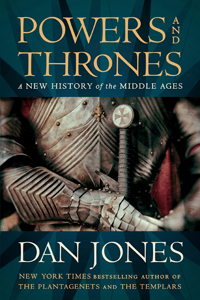 Dan Jones, Powers and Thrones: A New History of the Middle Ages (New York: Viking, 2021), 656pp.
Dan Jones, Powers and Thrones: A New History of the Middle Ages (New York: Viking, 2021), 656pp.
A review by Brad Keister, former Deputy Division Director of the Physics Division for the National Science Foundation. In 2018, Brad retired from the more formal demands of research and teaching, and lives in northern Virginia.
There are countless books covering the thousand-year span from the fall of Rome to the Protestant Reformation. A stated aim of Powers and Thrones is less to further scholarship and more to engage a twenty-first century reader. While not an original work of new scholarship, it is amply footnoted and builds on other published work. The author, Dan Jones, is a Fellow of the Royal Historical Society, and has also written books on related topics such as Crusaders (2019) and The Templars (2017).
One clear message of Powers and Thrones is that this millennium of years hardly merits the Dark Ages label. Rather, it was a time of immense upheaval and transformation leading to the world as we know it today, all the while exhibiting many of the issues we might think are unique to our time, such as climate change, pandemics, technological transformation and its societal aftermath. The book has a historical arc, but is organized by topics and themes, making it much more readable than a very long chronology of events.
In the absence of a stable Roman Empire (whose stability eroded over centuries), Europe was wracked by tribal (‘barbarian’) infighting, the rapid sweep of Islam across the continent, and invasions from the East (Mongols). Nations as we know them now did not exist. Instead, there was a delicate evolving balance of power amongst local rulers, warriors, and the church. In its day, warfare technology led to the role of armored knights as protectors of a domain, and the establishment of the Knights Templar, whose members took similar pious vows to that of monks. The church witnessed a rapid development of monasteries as many individuals saw these as a favorable alternative to poverty or armed service: at its peak, monasteries associated with the abbot of Cluny numbered 1,500 — such abbots enjoyed influence with popes and kings. The intertwining of religion and politics (accommodating, adversarial and sometimes violent) persists to this day.
As European nations looked for trade routes to the East that avoided the Ottoman Empire (fully established in power with the overthrow of Constantinople in 1453), they stumbled upon the Americas instead. In an eerie parallel to modern social media, the development of printing in the fifteenth century enabled Martin Luther’s Theses, as the author states, to go ‘viral’ a short half-century later, leading to societal upheaval and violent wars.
The author concludes this fast-paced book (in spite of its length of close to 700 pages) with the question, “Is it possible that we not only can be interested in, but may even sympathize with, the people who lived through the topsy-turvy Middle Ages?” I would say yes, and add “learn from” as well. The Sunday Times in the UK called Powers and Thrones "simply the best popular history of the Middle Ages there is."
Dan Clendenin: dan@journeywithjesus.net


